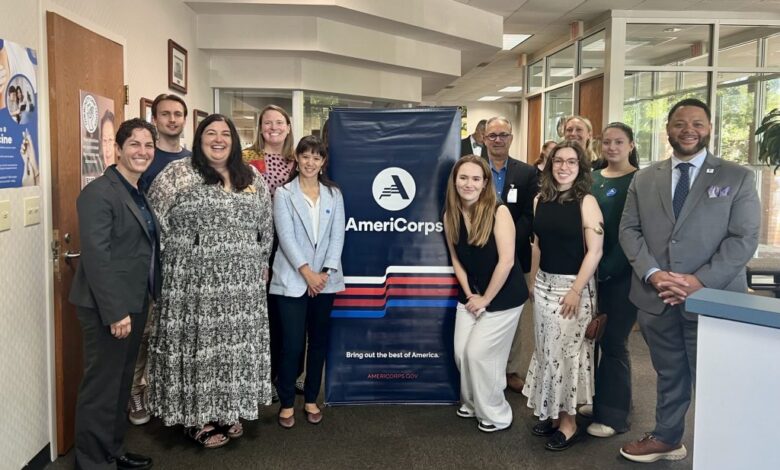Building the next generation of public health workers


By Rachel Crumpler
The COVID-19 pandemic shined a light on the critical role of public health workers. Even as many people were losing jobs and hunkering down, they mobilized quickly to provide education on masking, vaccinated millions of people, followed data trends to identify and contain outbreaks of infection and much more.
The work was visible as society reeled from an unprecedented health emergency that disrupted life for so many.
But even when a public health emergency isn’t looming large in society, public health workers stay busy tackling ongoing public health challenges, such as the youth mental health crisis and the opioid epidemic, or completing the more ordinary yet vital tasks of inspecting restaurants and collecting health data.
These workers are the bedrock of community health, often the first line of prevention in working to keep people healthy and the first to respond to emerging public health threats.
But their responses are dictated by the size and skill of the public health workforce, and the performance of essential public health tasks is increasingly strained by staffing shortages.
An innovative partnership between the Centers for Disease Control and Prevention and AmeriCorps — the federal agency for volunteering and national service — aims to help build a new generation of public health workers while addressing urgent public health needs.
Since Public Health AmeriCorps launched in 2021 with funding from federal American Rescue Plan dollars, more than 6,000 members have served at more than 1,400 locations across the United States. In North Carolina, 214 Public Health AmeriCorps members are serving at local nonprofits, health departments and clinics and boosting their capacity to respond to health needs.
These workers are positioned across the state on the front lines of public health — from growing community gardens to address food deserts and food insecurity in eastern North Carolina to responding to the health needs in the aftermath of Helene in western North Carolina.
“The pandemic gave all of us across the country a crash course in what public health does and what public health looks like in a way that in our lifetimes, I think, we hadn’t seen before,” said AJ Pearlman, director of Public Health AmeriCorps.
“Even though we might be out of the public health emergency, we have ongoing needs. We need a workforce that can — day in and day out — protect individuals, provide accurate information and work to save lives. That is what the public health workforce does.”
Shortage of workers
A 2021 analysis estimated that state and local health departments across the country needed to hire 80,000 more full-time employees to provide core public health services to meet the nation’s needs.
Instead, in recent years, the public health workforce has been contracting, losing around 40,000 employees between the 2009 Great Recession and the COVID-19 pandemic. Additionally, it’s estimated that nearly half of all employees in state and local public health agencies left between 2017 and 2021, with the highest rate among workers ages 35 and younger.
Thousands more left the workforce during the pandemic and after, driven by burnout from heavy workloads and harassment as the public’s response to the COVID pandemic became increasingly polarized.
If exodus trends continue, one study in Health Affairs estimated that by 2025, as much as half the governmental public health workforce would be turned over — an extraordinary loss of expertise and institutional knowledge.
Employees reported low pay, lack of opportunities for advancement, heavy workloads and chronic stress as reasons for leaving in a 2021 Public Health Workforce Interests and Needs Survey.
A reduced public health workforce, Pearlman said, “limits our ability to collect data, to do research, to evaluate what we’re doing — and all of those things are key to understanding what’s going on in our communities and how we can improve health now and into the future.”

Pearlman worked in the U.S. Department of Health and Human Services as chief of staff for COVID-19 response and saw up close the challenges of the public health workforce and infrastructure.
Top among them is a lack of steady resources and funding which affects job stability and pay, Pearlman said. The United States spent about $4.5 trillion on health in 2022 but devoted less than 5 percent of that total to public health and disease prevention. And while an infusion of cash was allocated to public health during the pandemic, that funding is tapering off, leaving some communities in a lurch again.
“There’s a need for more people,” Pearlman said. “There’s a need for engagement, and there’s a continued need for public health resources across the country if we are going to appropriately respond to what our nation’s needs are.”
The Public Health AmeriCorps program seeks to create pathways to the field of public health and thus bring a needed boost to the workforce pipeline.
Corps members complete a year of service in a local health setting, where they gain on-the-ground experience performing various public health duties, exposing them to the field. Meanwhile, local communities benefit from their 900 hours of service tackling health challenges in the area.
The program is already having an impact on attracting a more diverse workforce, Pearlman said. Public Health AmeriCorps participants have diverse entry points into the field, with some joining out of high school or college interested in learning more about public health, while others join seeking a second career.
Although members range in age from 17 to 82, Pearlman said Public Health AmeriCorps members tend to be younger, more racially diverse and earlier in their professional careers than the existing public health workforce.
“We’re really trying to drive that new generation of individuals into the field to help address some of these ongoing challenges,” Pearlman said.
Public health in action
Senior leaders from AmeriCorps and the CDC traveled to Winston-Salem last month to see a site where corps members are making an impact. They visited the Community Care Center — a clinic serving uninsured residents in Forsyth, Davie and Stokes counties — which is hosting four corps members this year.

During the visit, the federal agencies awarded Wake Forest University’s Public Health AmeriCorps program just over $200,000 to continue the program for a third year. The funds will allow 15 members to serve in Forsyth County at various organizations, including Trellis Supportive Care, Cancer Services and Atrium Health Wake Forest Baptist Mobile Health Clinic.
“It’s a triple win,” AmeriCorps CEO Michael Smith said during the site visit. “Not only is it impacting communities like the one here, but it’s impacting the members who are going to get the skills that they need to transform their lives, and I think it’s also impacting society that is going to respond to that public health shortage and have an extraordinary talent pipeline.”
Paul Jeffrey, executive director and CEO of Community Care Center, said clinic services are primarily driven by volunteers and that the Public Health AmeriCorps members have been vital to maintaining continuity of care.
They tackle many roles, including patient triage, lab work and assisting with grant writing.
Rafaela Capelate De Oliveira, a corps member who started her year of service in September at the Community Care Center, said she spends much of her time providing translation services for patients and doctors who are treating them.
About 75 percent of the center’s patients are Spanish-speaking, and many do not have insurance. It’s an experience Capelate De Oliveira relates to; she said she immigrated to the U.S. from Brazil when she was younger and spent years without health insurance.
“Having a background as being Latina and being the interpreter for my family, it was something that was really near and dear to my heart to continue being that bridge of communication that a lot of families need,” she said.
“I want to continue building that bridge and trust with the community.”
And Capelate De Oliveira said public health extends far beyond the clinic walls. Social determinants of health — factors like housing, food access and education — play a role in who is ending up in the clinic in the first place and how they are able to manage their health.

In addition to Wake Forest University, two other sites in North Carolina have been awarded grants to host Public Health AmeriCorps programs: Appalachian State University and Pamlico Rose Institute for Sustainable Communities. Over the past three years, these North Carolina sites have received more than $2.7 million in federal funds.
Public Health AmeriCorps members at the Pamlico Rose Institute have built three large wellness gardens aimed at promoting access to healthy food in rural Beaufort County — an area rife with food deserts — along with providing educational programs on healthy eating and gardening.
Appalachian State’s Public Health AmeriCorps program is focused on enhancing public health preparedness and mental health training in 25 rural western North Carolina counties. This work was put to use in Helene’s aftermath when AmeriCorps members were prepared for the response.
“It is that sort of pre-work that is vital in public health to be able to jump in quickly when a natural disaster or a crisis hits,” Pearlman said.
New view of public health
Safa Jan, a Wake Forest student, was part of the first cohort of members in 2022. She worked at the Forsyth County Department of Public Health, where she focused on overdose awareness and education on how to reverse an overdose using the drug naloxone. These efforts often took her to community events to connect with folks. She’s now in her third year as a Public Health AmeriCorps member working at Trellis Supportive Care — a hospice and palliative care provider — supporting patients.
“Public health was on my radar, but I didn’t realize how important it was truly until doing this program, and how important, especially preventative health is for the entire health of the community,” Jan said.
Chris Dietrich, a junior at Wake Forest who completed his AmeriCorps year of service at the Community Care Center, agreed that his experiences in the clinic and patient interactions expanded his understanding of public health.
Dietrich plans to go to medical school and said his year in the clinic has solidified for him the need to think about health holistically, including how someone’s health is a reflection of the many factors outside of the health care system — transportation, housing, diet, education — that determine people’s health.
“When you’re in the doctor’s office, that’s when the issues become urgent — but the medical journey starts from what circumstances they were born into,” said Dietrich, explaining the importance of public health’s early interventions.
Pearlman said that although the public health workforce is up against some tough funding and resource challenges, she is optimistic about the impact of the thousands of Public Health AmeriCorps members infusing new strength into the public workforce.
“I truly believe that this program has catalyzed new ways of thinking in communities for how public health and community-based organizations can work together to improve community health,” she said.
The post Building the next generation of public health workers appeared first on North Carolina Health News.
